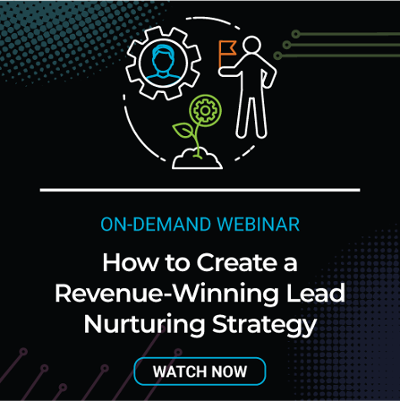Lead Nurturing Email Workflows to Use During the Buyer’s Journey
Having a well-thought-out strategy for engaging and converting potential buyers is imperative for businesses. That's where lead nurturing email...
5 min read
 Amanda Meade
:
August 21, 2023
Amanda Meade
:
August 21, 2023


Are you struggling to turn your leads into loyal customers? If so, it's time to explore the power of lead nurturing. Simply generating leads is not enough; you need a strategy to convert those leads into long-lasting customers.
Lead nurturing is a proven method that can transform your business by building relationships with potential customers and guiding them through the buyer's journey. By delivering personalized and relevant content at each stage, you can engage and educate your leads, ultimately increasing their trust and likelihood to purchase.
In this article, we will dive deep into the world of lead nurturing and explore how it can benefit your business. From understanding the buyer's journey to creating compelling and targeted content, we'll provide you with practical tips and strategies that can take your lead nurturing efforts to the next level.
Don't let your leads slip away. Discover the power of lead nurturing and unlock the potential of turning your leads into loyal customers.
 Many businesses experience the frustration of investing time and resources into lead generation, only to have those leads slip through the cracks and never convert into customers. This is where lead nurturing comes into play.
Many businesses experience the frustration of investing time and resources into lead generation, only to have those leads slip through the cracks and never convert into customers. This is where lead nurturing comes into play.
Lead nurturing is the process of building relationships with potential customers and guiding them through the buyer's journey. It involves delivering personalized and relevant content to educate and engage leads, with the ultimate goal of converting them into loyal customers.
By nurturing your leads, you can establish trust, address their pain points, and showcase the value of your products or services. This not only increases the likelihood of conversion but also builds brand loyalty, leading to repeat business and positive word-of-mouth referrals.
How do you create an effective lead nurturing campaign? Here are some key strategies and tips to consider:
1. Segment your leads: Not all leads are the same, and they may have different needs and interests. Segmenting your leads based on their demographics, behaviors, or interests allows you to deliver more personalized and targeted content. This increases the relevancy of your messaging and improves the chances of engagement and conversion.
2. Develop a content strategy: Content is at the core of lead nurturing. Develop a content strategy that aligns with the buyer's journey and addresses the needs and pain points of your leads. Create a mix of educational blog posts, informative videos, case studies, and interactive content to engage your leads at each stage.
3. Automate your campaigns: Automation tools and software can streamline your lead nurturing efforts and ensure consistent and timely communication with your leads. Set up automated workflows that deliver the right content to the right leads at the right time. This saves you time and effort while maintaining a personalized touch.
4. Use multiple channels: Don't limit yourself to just one channel for lead nurturing. Leverage multiple channels such as email marketing, social media, webinars, and personalized landing pages to reach your leads where they are most active. This multi-channel approach increases your chances of engagement and conversion.
5. Test and optimize: Lead nurturing is an iterative process. Continuously test and optimize your campaigns to improve their effectiveness. Analyze metrics such as open rates, click-through rates, and conversion rates to identify areas for improvement. A/B testing different subject lines, content formats, and calls-to-action can help you refine your approach and achieve better results.
By implementing these strategies, you can create effective lead nurturing campaigns that engage, educate, and convert your leads into loyal customers.
To effectively implement lead nurturing strategies, it's essential to choose the right tools and software. Here are some factors to consider when selecting lead nurturing tools:
1. Automation capabilities: Look for tools that offer automation capabilities, such as email automation, workflow automation, and lead scoring. These features streamline your lead nurturing efforts and ensure consistent and timely communication with your leads.
2. Integration with CRM systems: Integration with your customer relationship management (CRM) system is crucial for seamless lead management and tracking. Choose tools that seamlessly integrate with your existing CRM system to ensure a smooth flow of data and information.
3. Personalization options: Assess the personalization options offered by the tools. Look for features such as dynamic content, behavior-based triggers, and customizable templates. These features enable you to deliver personalized and targeted content to your leads.
4. Analytics and reporting: Effective lead nurturing requires continuous monitoring and optimization. Choose tools that provide robust analytics and reporting capabilities. These features allow you to track key metrics, measure the success of your campaigns, and make data-driven decisions for improvement.
5. Scalability: Consider the scalability of the tools. As your business grows, you may need to handle a larger volume of leads and scale your lead nurturing efforts. Ensure that the tools you choose can accommodate the growth and evolving needs of your business.
By carefully evaluating your requirements and selecting the right lead nurturing tools and software, you can streamline your efforts and maximize the effectiveness of your lead nurturing campaigns.
To inspire and guide your lead nurturing efforts, let's look at some examples of successful lead nurturing campaigns:
1. HubSpot: HubSpot is a leading marketing automation software provider that excels in lead nurturing. Their campaigns focus on delivering valuable educational content to leads, guiding them through the buyer's journey. With personalized emails, targeted content recommendations, and behavior-based triggers, HubSpot nurtures leads effectively and consistently.
2. Dropbox: Dropbox's lead nurturing campaigns are known for their simplicity and effectiveness. They use personalized emails to educate leads on the benefits of their cloud storage solution. By offering free trials and providing step-by-step guides, Dropbox nurtures leads and encourages them to upgrade to paid plans.
3. LinkedIn: LinkedIn's lead nurturing campaigns leverage personalized content and social proof to engage leads. They send personalized emails with relevant industry insights, job recommendations, and networking opportunities. By delivering value and showcasing their expertise, LinkedIn nurtures leads and encourages them to become active users of the platform.
While lead nurturing can be a powerful strategy, there are common mistakes that businesses often make. By avoiding these pitfalls, you can maximize the effectiveness of your lead nurturing campaigns. Here are some common mistakes to watch out for:
1. Lack of personalization: Generic and impersonal content can turn off leads and decrease engagement. Avoid sending one-size-fits-all messages and instead, focus on delivering personalized and relevant content that addresses the specific needs and pain points of your leads.
2. Overwhelming with information: Bombarding leads with too much information can be overwhelming and counterproductive. Instead, focus on providing value through bite-sized content that is easy to consume and understand. Gradually nurture leads with relevant information at each stage of the buyer's journey.
3. Neglecting lead scoring: Lead scoring is a valuable tool in prioritizing and segmenting your leads. Assign scores to leads based on their engagement, behaviors, and demographics. Neglecting lead scoring can result in inefficient lead management and missed opportunities.
4. Lack of follow-up: Consistent and timely follow-up is critical in lead nurturing. Failing to follow up with leads can lead to lost opportunities and decreased engagement. Set up automated workflows or reminders to ensure that no leads slip through the cracks.
5. Ignoring feedback and data: Lead nurturing is an iterative process, and feedback and data are invaluable in improving your campaigns. Pay attention to the metrics, feedback, and insights from your leads. Use this information to refine your approach, test new strategies, and optimize your campaigns.
To implement lead nurturing strategies successfully, consider the following next steps:
Assess your current lead nurturing efforts: Evaluate your current lead nurturing efforts and identify areas for improvement. Analyze your content, messaging, and tools to ensure they align with the buyer's journey and deliver value to your leads.
Segment your leads: Segment your leads based on their demographics, behaviors, or interests. This allows you to deliver more personalized and targeted content, increasing engagement and conversion.
Develop a content strategy: Develop a content strategy that aligns with the buyer's journey and addresses the needs and pain points of your leads. Create a mix of educational and informative content to engage and nurture your leads at each stage.
Choose the right lead nurturing tools: Select lead nurturing tools and software that align with your requirements and integrate seamlessly with your existing systems. Look for automation capabilities, personalization options, and robust analytics and reporting features.
Monitor and optimize your campaigns: Continuously monitor the performance of your lead nurturing campaigns and make data-driven decisions for improvement. Track key metrics, analyze the data, and test different strategies to optimize your campaigns and achieve better results.
By implementing these strategies and taking the necessary steps, you can unlock the potential of lead nurturing and transform your business. Don't let your leads slip away – nurture them, build relationships, and turn them into loyal customers.

Having a well-thought-out strategy for engaging and converting potential buyers is imperative for businesses. That's where lead nurturing email...

Lead nurturing has become an essential part of any successful marketing strategy. When done right, it can significantly enhance engagement and...

Ask any salesperson about the challenges they face, and most will tell you that prospecting is the toughest part of the sales process. It’s hard to...